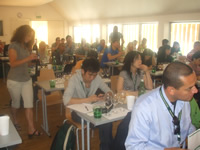 |
| Wine Tasting at Wine Academy Austria |
Before we talk the knots and the crosses, it is helpful to know that the country has only 4 regions with a total of 16 sub-regions. Niederösterreich (lower Austria) comprises of Weinviertel, Kamptal, Kremstal, Wachau, Traisental, Wagram (till recently known as Donauland), Carnuntum and Thermenregion. Wien (Vienna) is a small region in and around the capital city. The third region Burgenland is divided into Neusiedlersee, Neusiedlersee-Hügelland, Mittelburgenland and Südburgenland. The Southernmost region Steiermark (Styria) is divided into Südost Steiermark
(South-east Styria), Süd Steiermark (South Styria) and Weststeiermark (West Styria).
Most of vine growing is restricted to the western belt from top to the bottom of Austria. Being relatively unknown in the outside world (Majority of its exports go to Germany and Switzerland where the German terminology and the grapes are perhaps well understood. But a novice may find too many knots some of which I am sharing with the readers after my visit to these parts.
The number of crosses in their varietal will amuse any outsider. There are 22 white wine varieties and 13 red varietals used in the recognised quality wines, with a significant number using a varietal which is a cross between two or more varieties.
KNOTS
Whether there are areas, grape varieties, type or style of wine or just some label peculiarities Austrian wines can be full of knots that one needs to untangle to make it simpler to understand the wines. One must not confuse it with the Kangaroo land Australia. This is strictly veal and lard-loving Wiener Schnitzel region.
Following are a few of the terminologies you might want to untangle in your mind for better understanding.
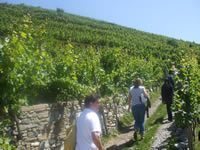 |
| Steep Vineyards of Hirtberger in Spitz, Wachau |
Lower Austria (Niederösterreich) - The largest quality wine-growing area in Austria is located on the North-West part of Austria. So why should it be called Lower Austria- I wondered till Susanne Staggl of AMWB, a diploma holder from WSET and now working for MW, explained that there was one part of Austria which was hilly and at higher altitude-known as upper Austria.
Chardonnay- When Chardonnay became popular about 20 years ago many wineries started labeling their Pinot Blanc as chardonnay to catch the popularity and called them Pinot Chardonnay, In Styria the grape is known as Morillon. Also, there are terms like Classic and Tradition used for their wines-indicating only that they are unoaked and more fruity in flavour.
Roter Veltliner- is a white grape variety that produces a yellowish green white wine with subtle spicy flavour with a strong acidity-and has nothing to do with the rot-or red colour.
Same goes for Rotgipfler and Frühroter Veltliner which are a white variety.
Furmint- Think Furmint and you are automatically transported to Tokay in Hungry where this is the main grape for Tokai, though Croatia also lays claim to growing this varietal. Here in Austria, it should remind you immediately of Ruster Ausbruch and exquisite sweet wine from Rust.
Welschriesling- Austria’s second highest grown variety with 8.9% share has nothing to do with Riesling. Planned mostly in Burgenland and Lowe Austria, it is also grown in Styria but not in a big way. Makes both fruity, spicy, fresh and young dry wines as well as noble sweet wines, especially TBAs.
Schilcher- What do you say when your host suddenly springs on you,’ how about a Schilcher?’ You may be disappointed if you are expecting a glass of cold beer. Chilled it will be, but don’t show surprise on getting a glass of Rosé. In West Styria, the rose-style wine, even a bubbly, is made from the ancient grape variety, Blauer Wildbacher. The wine is usually dry, aggressively crisp, robust and slightly tannic with the colour of Salmon. Choose a fruity appetizer or even as a refined sweet wine.
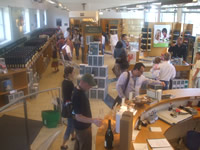 |
| Wine Shop at the winery-Domaine Wachau |
A tasting following a presentation, ‘Wine Wonderland’ Austria by Willi Klinger, MD of Austrian Wine Marketing Board, at the Rust based Austrian Wine Academy (which claims to have more students registered for MW than London and handles 20,000 students every year in various programmes), and a lecture on the Diversity of Wines from Styria and Burgenland, started with Schilcher from Franz and Christine Strohmeier in West Styria. Though a decent, well made wine, I found it too tart with citric notes and berry flavours. It needs a lot of fats to balance the aggressive acidity. Perhaps, it would be a good combo for liver pâté, or the typical Wiener Schnitzel, crispy veal fried in lard. I would have loved to try it with chana-bhaturas!
Ausbruch- Austrians follow the similar nomenclature system like German Riesling sweet wines: Spätlese, Auslese, Beerenauslese (BA) and Trockenbeerenauslese (TBA), based on the sugar content of the grape while harvesting measured in KMW, Öchsle or Beaumé. However, there is an intermediate category between BA and TBA, known as Ausbruch. Ruster Ausbruch is rather famous (but more on this in another future article).
Strohwein – The straw wine produced on the same principles as Vin Santo in Italy, where the over-ripe grapes are stored and air-dried on straw or reeds for at least 3 months,
Also known as schilfwein, the Tradition Shilfwein 2004 by Nekowitsch, made from a blend of Welschriesling, Morillon (Chardonnay) and Scheurebe was actually a gold yellow colour nectar with plenty of sugar (262 gms/lt) but with low alcoholic content of 10%, with an amazingly balanced acidity that made twirling it around the palate for a long time, a pleasure.
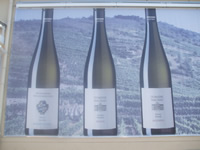 |
| Wachau Wines-Domaine Wachau- Steinfeld etc. |
Smaragd- This label on a bottle cam put you in knots because nowhere else in the world you would find the label or the logic. Actually, even in Austria, nowhere but Wachau uses this terminology-based only on the alcohol content. This is perhaps the only region in the world that defines wine by the alcohol category.
Any Wachau wine with less than 11.5% makes it a Steinfelder. The mid range 11.5-12.5% is known as Federspiel. The high end (alcohol that is) wines having more than 12.5% are categorized as Smaragd. In practice, they are fuller bodied with 13-13.5% alcohol.
A Klaus Federspiel 2008from Jamek with 12% alcohol was a delicious dry Riesling with a slight smokiness and earthiness but a Singerriedel (name of the premier vineyard in the region) Smaragd from Hirtzberger and a Kellerberger Grüner Veltliner Smaragd from F.X. Pichler were both outstanding wines-very near perfection, both of them-though slightly different in style. The former was brilliant, golden yellow, with mineral notes and racy acidity, slightly off-dry, and great structure with a very long taste while the latter was a concentrated, full bodied peppery, well balanced and complex wine.
The boat ride from a small town of Spitz in Wachau to Dürnstein saw us tasting four Federspiel 2008- from Sigl, Lagier, Knoll and Jäger, all dry and ranging from 12-12.5% alcohol. All very pleasant wines to enjoy the Danube ride. It was nice to learn later that they were priced very affordable-Knoll being a better known winery being slightly more expensive than the others. They make good everyday, picnic or aperitif wines.
CROSSES:
Although the famous international varietals Cabernet Sauvignon, Shiraz and Chardonnay, also grown in Austria as varietals are crosses, several of the indigenous grape varieties in Austria are crosses and one needs to have some understanding of these varietals.
Grüner Veltliner- The most grown variety with 36% of total plantings is a cross between a yet unknown grape variety and Traminer which gives the grape its longevity quality. It is a rather neutral grape.
Wines tasted from Sommer, Hans and Anita Nitthaus (outstanding), Liegenfeld,Harlti Toni, Prieler,Kloster and Birgit Braunstein at the tasting of Northern Burgenland were very good.
Frühroter Veltliner- It is an early ripening, natural cross between white Roter Veltliner and Sylvaner. It is not a trendy variety and grows as only 1.3% of total Austrian crop and its production is decreasing.
Grüner Sylvaner- The continuing lower production of this cross between Traminer and Österrichisch Weiss –both white varieties.
Müller Thurgau (Rivaner)- The German varietal is a cross between Riesling and Madelaine Royal variety has been considered for years a cross between Traminer and Sylvaner and thus known as Rivaner. Cultivated primarily in the Lower Austria and Burgenland, it has 6.7% share of the Austrian vines and makes mostly young drinking wines.
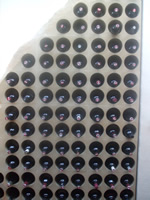 |
| Austrian wines with Quaity seal at the Nyikospark Restaurant in Burgland |
Muskat Ottonel- Related to the French Muscat, the cross also has Gutedel grape varietal. Part of the northland Burgenland vine region, it occupies a small 1.2 % of the area. Also makes some excellent straw-wine as a 2004 Schilfmandl (straw wine-made from drying of grapes on straws to concentrate sugar) tasted from the internationally well known and iconic producer Willi Opitz-the oily texture left the tropical fruit flavours long time on the mouth long time after it had left the gullet.
Neuburger- This typical variety found mostly in Burgenland and Lower Austria it is a typical Austrian grape which is a cross between the white Roter Veltliner and Sylvaner.
At the Pannonian Dinner (this refers to the flatlands of Hungary-east of Burgenland) in Restaurant Nyikospark in a small town, Neusiedl am See, everyone on out table found an inexpensive Neuburger2008 from Feiler-Artinger, a low alcohol 12.5%, very citrus, clean and crispy fresh with a slight mineral touch though the end was quite short-excellent aperitif wine that left a good impression on the palate. (Rating 3.5/5)
Scheurebe- Also labeled as Sämling on many bottles, this is perhaps the most successful German cross used in Austria and is a cross between Riesling and another wild variety often mistaken as Sylvaner. A versatile varietal it makes interesting noble sweet wines in Burgenland but also light, dry and crisp wines in Styria. A Burgenland Sämling Beerenauslese 2006 (124 gms residual sugar) from Gesellmann had a delicious peach flavour with great acid balance (4/5) and a Trocekbeerenauslese 2006 (364 gms /lt) from Angerhof Tschida (4.5/5) were a couple of excellent examples of Scheurebe tasting in the noble sweet wine tasting at the Neusiedlersee lakes side in Illimitz, Burgenland.
Zweigelt (Rotburgur)- By far the most planted red vine in the country , the intense cherry fruit aromas related vine grows in all 16 regions, covering 9% of the total area. It is a cross between the second ranked Blaufränkisch and the French grape St. Laurent which makes good wine by itself as a varietal, and gives spicy flavours that Indian palates would love.
Roesler- A cross between Zweigelt and Blaufränkisch it has yet a third lesser known Sevye-Villard varietal gives interesting aromas and deep colour
Blauburger – Yet another cross of Blaufränkisch and Blauer Portugieser, it is a popular blending grape due to its deep colour.
On a lighter note:
Klinger- Willi Klinger MD of the Austrian Wine Marketing Board (AWMB) is a bubbly cross between Burt Bacharach and Paul McCartney. Those present at the final day gala dinner held at the Gloriette in front of Schönbrunn Palace saw him doing the piano and belting out Beatle numbers while sipping and tasting 93 wines (ninety-three!) on offer, before, during and after the dinner.
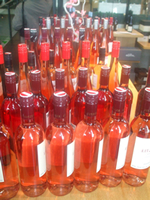 |
| Loisium- Rosé any one? |
And finally, Austrian Wine Marketing Board is a cross between German efficiency and Italian warmth, with Willi’s 6 years experience of working with Angelo Gaja in Italy as his exports manager in 2000-2006 having rubbed off during the last couple of years.
The whole programme had been looked after to the minutest details. Steininger Sauvignon Blanc 2007 Brut, The bubbly to be tasted at the Loisium Wine Museum in Langenlois, Kamptal-, the three bubblies from Szigeti Sektkelerei (sparkling wine cellars) –Grüner Veltliner Brut, a Prestige Brut (2 part Chardonnay, 1 part Blaufränkisch –a Salmon colour Rose with good body and crispy freshness that danced on the palate despite shorter bubbles) and a Muskat Ottonel extra dry (15 gms of residual sugar) were pre-organised and categorised in the Tasting Notes Guide and Notebook provided-which eventually became a great resource book..
Subhash Arora
Tags: Austria,Austrian Wine, |